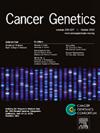Novel Co-frameshift mutations in N- and C-terminal regions of CEBPA in acute myeloid leukemia: A case report
IF 2.1
4区 医学
Q4 GENETICS & HEREDITY
引用次数: 0
Abstract
Acute myeloid leukemia (AML) is a hematologic malignancy marked by abnormal myeloid cell proliferation or differentiation arrest in the bone marrow. AML prognosis is influenced by genetic mutations, including in NPM1, FLT3-ITD, cKIT, and CEBPA genes. CEBPA, located on chromosome 19q13.11, is critical for myeloid differentiation in the hematopoietic system, and mutations in this gene occur in about 10–15 % of de novo AML cases. These mutations often appear as frameshift alterations in the N-terminal or in-frame insertions/deletions in the C-terminal basic leucine zipper (bZIP) domain. We report a unique CEBPA mutation profile in a 19-year-old male with AML, normal karyotype, and no mutations in FLT3-ITD, NPM1, or cKIT. The patient exhibited a frameshift mutation in the N-terminal region and a novel in-frame duplication in the C-terminal regions of CEBPA, which has not been previously reported in AML. This case emphasizes the importance of genetic profiling in identifying clinically relevant mutation patterns and highlights the potential of genetic insights to inform personalized treatment. It also underscores the need for further studies on the functional implications of unique CEBPA mutations in AML pathogenesis.
急性髓性白血病中CEBPA N端和c端区域的新型共移码突变:一例报告
急性髓系白血病(AML)是一种血液系统恶性肿瘤,其特征是骨髓中髓系细胞增殖异常或分化受阻。AML预后受基因突变的影响,包括NPM1、FLT3-ITD、cKIT和CEBPA基因。CEBPA位于染色体19q13.11上,对造血系统的髓系分化至关重要,约10 - 15%的新发AML病例发生该基因突变。这些突变通常表现为n端移码改变或c端碱性亮氨酸拉链(bZIP)结构域的帧内插入/缺失。我们报告了一个独特的CEBPA突变谱在一个19岁的男性AML,核型正常,没有突变的FLT3-ITD, NPM1,或cKIT。患者表现出在n端区域的移码突变和CEBPA c端区域的新的帧内重复,这在AML中以前没有报道过。本病例强调了基因图谱在识别临床相关突变模式中的重要性,并强调了遗传见解为个性化治疗提供信息的潜力。这也强调了进一步研究独特的CEBPA突变在AML发病机制中的功能意义的必要性。
本文章由计算机程序翻译,如有差异,请以英文原文为准。
求助全文
约1分钟内获得全文
求助全文
来源期刊

Cancer Genetics
ONCOLOGY-GENETICS & HEREDITY
CiteScore
3.20
自引率
5.30%
发文量
167
审稿时长
27 days
期刊介绍:
The aim of Cancer Genetics is to publish high quality scientific papers on the cellular, genetic and molecular aspects of cancer, including cancer predisposition and clinical diagnostic applications. Specific areas of interest include descriptions of new chromosomal, molecular or epigenetic alterations in benign and malignant diseases; novel laboratory approaches for identification and characterization of chromosomal rearrangements or genomic alterations in cancer cells; correlation of genetic changes with pathology and clinical presentation; and the molecular genetics of cancer predisposition. To reach a basic science and clinical multidisciplinary audience, we welcome original full-length articles, reviews, meeting summaries, brief reports, and letters to the editor.
 求助内容:
求助内容: 应助结果提醒方式:
应助结果提醒方式:


